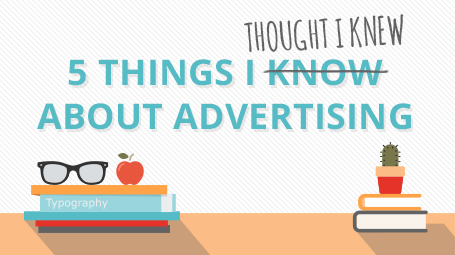5 Things I Thought I Knew About Advertising

I joined Texas Creative as an intern in January 2017. At the time, I thought I had a pretty good idea of how advertising works and what goes on behind the scenes at an agency. I didn’t.
In the months since then, I have tried my best to clear up any misconceptions that I had about advertising in order to better understand how it actually works in the real world.
I soon realized that going from someone who views a lot of ads to someone who makes them for a living is no easy task. Like a music lover learning to play an instrument; it’s not impossible, but it requires time, special knowledge and a lot of practice.
With that being said, here are the top five things I thought I knew about advertising:
1. ADVERTISING IS UNETHICAL AND DISHONEST
I still remember the first time I bought a McDonald's hamburger. Far from the juicy masterpiece I had been promised, the burger I received was sad, brown, and looked like someone sat on it. I felt deceived.
Nearly everyone has a story of a time they were ‘tricked’ by clever advertising or a deceptive sales person, which is why building and maintaining trust and rapport with customers is just as important as persuading them to buy. Companies will spend years earning the trust of their customers, and the quickest way to destroy that trust is to lie.
As the saying goes: “Fool me once, shame on you. Fool me twice, shame on me.” Deceptive tactics may convince a customer to buy your product once, but they won’t convince them to buy it a second time. In the end, there’s no margin in deception.
2. ADVERTISING SHOULD BE AS CREATIVE AS POSSIBLE
Don’t get me wrong, creativity is great. It’s what we do. But our clients don’t pay us to be funny or entertaining—they pay us to increase sales at the lowest possible cost.
In his book The Copywriter's Handbook, Robert Bly writes that “the biggest mistake you can make as a copywriter is to judge advertising the way lay people judge it.” That is to say, the funniest and most expensive ads don’t always sell the most stuff.
This doesn’t mean that ads shouldn’t be funny, provocative or visually stunning. Sometimes those ads perform better. But if a straight forward no frills sales pitch is going to sell more products than a talking llama, so be it. Our job is to find the best message for the product and the target audience. And that takes creativity.
3. TV AND PRINT ARE DEAD
Traditional advertising might not be the best way to reach a cord-cutting millennial like myself, but that doesn’t mean it’s on the way out.
Even with digital advertising on pace to outspend TV in 2017, there’s no denying the fact that for a large portion of the US population, TV is still king. Baby Boomers, who control 70% of the disposable income, watch over 44 hours of live TV a week.
I also learned that print, which has suffered the greatest losses in this digital age, still generates the greatest increases in brand favorability and purchase intent of any platform, according to a comprehensive analysis of nearly 100 ad effectiveness studies by Millward Brown.
Just like radio survived the advent of television, traditional advertising will survive the shift towards digital and remain a viable option for years to come.
4. SLOGANS ARE KING
One of the biggest misconceptions I had about advertising was the relative importance of a slogan. Isn’t that why people hire ad agencies—to come up with catchy slogans for everything? It’s hard to ignore the impact of iconic taglines like “Think different”, “I’m lovin’ it” or “15 minutes could save you 15% or more on car insurance”, but in the real world, advertising is much, much more than coming up with clever catch phrases.
5. NO ONE CARES WHAT THE INTERN THINKS
At the beginning of my internship, I had the notion that ad agencies were run like some kind of feudal kingdom, with executives and creative directors wielding absolute power over their subordinates. Elsewhere, this may be true, but I was quickly surprised to learn that the higher ups not only tolerated my ideas, but actively encouraged them.
Why would a creative director with 20 years of experience care what an intern thinks? As it turns out, coming up with ideas is not some special privilege reserved only for the highly qualified, and smart agencies cultivate an environment where good ideas are pushed to the top.
Fortunately, no one was expecting the intern to hit it out of the park on his first try. Those skills come with experience. As David Parker, our Creative Director and Vice President, puts it: “It takes 99 bad ideas to get a good one, and as you get older you just start higher up the list.”
But the most important lesson I’ve learned is that there is much more to advertising than just good copywriting and graphic design. There are a million little things that go on behind the scenes to bring an ad to life, and those aren’t always visible in the final product. So while I know more now than when I started, I’m more aware than ever of everything I still have to learn. But all in good time—I can’t expect to learn advertising by watching television.
Ready to hear what the pros have to say? Check out the rest of our blogs.